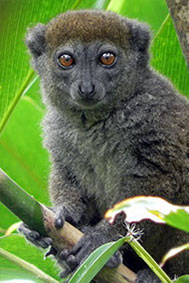Northern Bamboo Lemur
Hapalemur occidentalis
Conservation status
Vulnerable (IUCN Red List, 2020)
Family
Indriidae
What they look like
Northern bamboo lemurs are small primates with long tails. Their head and body length is only about 10 inches, but their tails can be as long as 15 inches. All northern bamboo lemurs have a gray-brown coat and a slightly paler gray face. Their noses and faces are smaller than many other lemurs.
Where they live
In the wild, they are found across northeastern and northwestern Madagascar and even in the northern tip of the island. Eight national parks maintain sizeable populations including Marojejy, Masoala, Ankarana, Zahamena, Sahamalaza, Tsingy de Namoroka, Mananara-Nord, and Baie de Baly. They inhabit a wide range of habitats, including many rain forests in northeastern Madagascar as well as the dry “Sambirano” forests in the northwest. They are one of the more flexible lemur species and also exist in some secondary disturbed forests as well the fringes of cacao plantations and other agricultural land. As its name suggests, this species is almost always associated with stands of bamboo or bamboo vines, although their diet can be remarkably diverse including many non-bamboo foods in disturbed forests.
What they eat
Northern bamboo lemurs eat bamboo, as well as other grasses, shrubs, wild ginger stalks, and a variety of domestic fruits (lychee, jackfruit, papaya) in secondary disturbed forests.
How they behave
Northern bamboo lemurs are the smallest lemur active during the day. These lemurs are not well studied, but researchers have also observed after-dark activity and vocalizations indicating that this is a cathemeral species, active in the night and day. Groups sizes can range from four up to eleven in the primary forests of Marojejy National Park.
How they reproduce
The northern bamboo lemur reproduces from summer into the fall, though actual mating is believed to occur on just one day per year, as in most other lemurs. Females are sexually receptive (estrus) for only a 24-hour period. Birthing season runs from October to January. Females always deliver a single infant, typically every other year. Mothers will diligently carry their baby by mouth for the first several weeks after birth until the infant is able to move onto her back. Eventually she is able to leave the infant “parked” in one spot for short periods of time while she goes off to forage.
What threats they face
The main threat facing northern bamboo lemurs is habitat loss due to slash-and-burn agriculture as well as bushmeat hunting. Natural predators include hawks, boa constrictors, fossa (Madagascar’s largest carnivore, related to the mongoose with qualities of a cat), as well as domestic cats and dogs.
Northern bamboo lemurs in Marojejy National Park and Anjanaharibe-Sud Special Reserve
This lemur is most easily seen at Camp 1 of Marojejy National Park and Antanetiambo Nature Reserve near Andapa. They are also encountered at low densities in Anjanaharibe-Sud Special Reserve.
